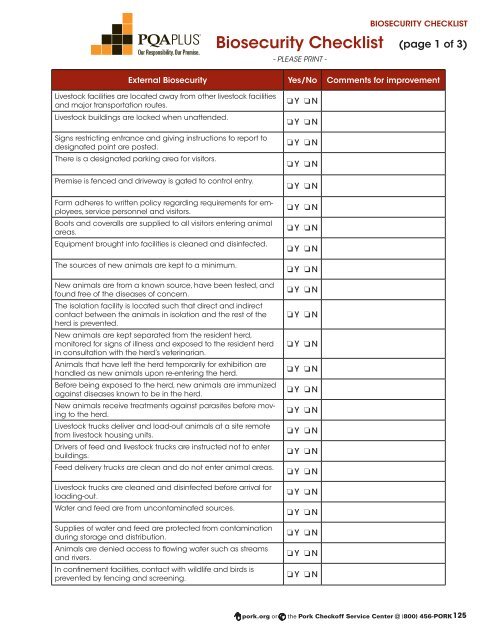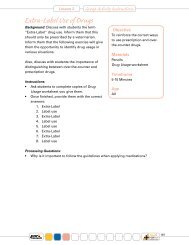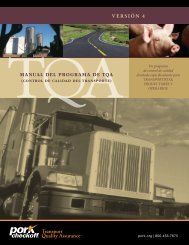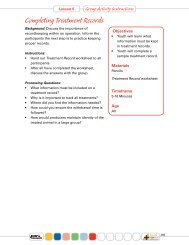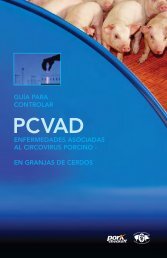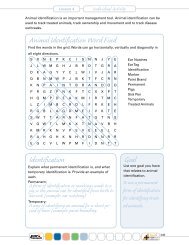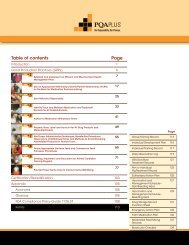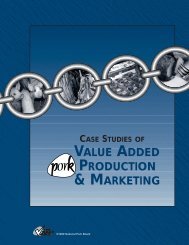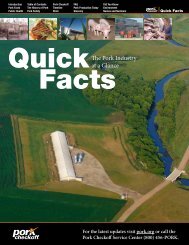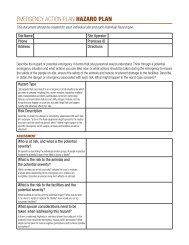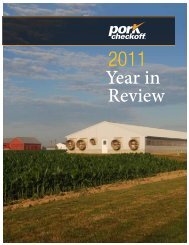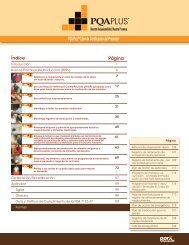Biosecurity Checklist
Biosecurity Checklist
Biosecurity Checklist
Create successful ePaper yourself
Turn your PDF publications into a flip-book with our unique Google optimized e-Paper software.
<strong>Biosecurity</strong> <strong>Checklist</strong><br />
- PLEASE PRINT -<br />
BIOSECURITY CHECKLIST<br />
(page 1 of 3)<br />
External <strong>Biosecurity</strong> Yes/No Comments for improvement<br />
Livestock facilities are located away from other livestock facilities<br />
and major transportation routes.<br />
Livestock buildings are locked when unattended.<br />
Signs restricting entrance and giving instructions to report to<br />
designated point are posted.<br />
There is a designated parking area for visitors.<br />
Premise is fenced and driveway is gated to control entry.<br />
Farm adheres to written policy regarding requirements for employees,<br />
service personnel and visitors.<br />
Boots and coveralls are supplied to all visitors entering animal<br />
areas.<br />
Equipment brought into facilities is cleaned and disinfected.<br />
The sources of new animals are kept to a minimum.<br />
New animals are from a known source, have been tested, and<br />
found free of the diseases of concern.<br />
The isolation facility is located such that direct and indirect<br />
contact between the animals in isolation and the rest of the<br />
herd is prevented.<br />
New animals are kept separated from the resident herd,<br />
monitored for signs of illness and exposed to the resident herd<br />
in consultation with the herd’s veterinarian.<br />
Animals that have left the herd temporarily for exhibition are<br />
handled as new animals upon re-entering the herd.<br />
Before being exposed to the herd, new animals are immunized<br />
against diseases known to be in the herd.<br />
New animals receive treatments against parasites before moving<br />
to the herd.<br />
Livestock trucks deliver and load-out animals at a site remote<br />
from livestock housing units.<br />
Drivers of feed and livestock trucks are instructed not to enter<br />
buildings.<br />
Feed delivery trucks are clean and do not enter animal areas.<br />
Livestock trucks are cleaned and disinfected before arrival for<br />
loading-out.<br />
Water and feed are from uncontaminated sources.<br />
Supplies of water and feed are protected from contamination<br />
during storage and distribution.<br />
Animals are denied access to flowing water such as streams<br />
and rivers.<br />
In confinement facilities, contact with wildlife and birds is<br />
prevented by fencing and screening.<br />
❏ Y ❏ N<br />
❏ Y ❏ N<br />
❏ Y ❏ N<br />
❏ Y ❏ N<br />
❏ Y ❏ N<br />
❏ Y ❏ N<br />
❏ Y ❏ N<br />
❏ Y ❏ N<br />
❏ Y ❏ N<br />
❏ Y ❏ N<br />
❏ Y ❏ N<br />
❏ Y ❏ N<br />
❏ Y ❏ N<br />
❏ Y ❏ N<br />
❏ Y ❏ N<br />
❏ Y ❏ N<br />
❏ Y ❏ N<br />
❏ Y ❏ N<br />
❏ Y ❏ N<br />
❏ Y ❏ N<br />
❏ Y ❏ N<br />
❏ Y ❏ N<br />
❏ Y ❏ N<br />
125
BIOSECURITY CHECKLIST<br />
(page 2 of 3)<br />
<strong>Biosecurity</strong> <strong>Checklist</strong><br />
- PLEASE PRINT -<br />
Internal <strong>Biosecurity</strong> Yes/No Comments for improvement<br />
Health of the herd is monitored by observations, testing and<br />
production records.<br />
Disease control/prevention programs, including deworming, vaccination,<br />
and medication protocols, are designed in consultation<br />
with a veterinarian.<br />
Animals are housed and fed in ways to minimize stress, crowding,<br />
and fighting.<br />
Animals are housed separately by age groups and moved using<br />
all-in/all-out pig flow.<br />
Pens are cleaned and disinfected between groups.<br />
Personnel duties are assigned in a manner to minimize the risk of<br />
spreading diseases between groups within the herd.<br />
Sick animals are immediately treated and/or removed from groups<br />
to treatment areas to reduce exposure to others.<br />
Any unusual illness is immediately brought to the attention of the<br />
herd veterinarian.<br />
Professional pest control services are used to prevent rodent and<br />
insect infestations.<br />
Building design and maintenance discourage the entry and harborage<br />
of pests.<br />
Access to feed by rodents is minimized by storage in rodent-proof<br />
containers and the prompt clean-up of spills.<br />
Moribund and dead animals are immediately removed from the<br />
animal area.<br />
Dead animals are disposed of promptly in an approved manner<br />
to prevent spread of disease, cannibalism, and the attraction of<br />
scavengers<br />
Access to manure by animals is reduced by timely cleaning and<br />
removal.<br />
❏ Y ❏ N<br />
❏ Y ❏ N<br />
❏ Y ❏ N<br />
❏ Y ❏ N<br />
❏ Y ❏ N<br />
❏ Y ❏ N<br />
❏ Y ❏ N<br />
❏ Y ❏ N<br />
❏ Y ❏ N<br />
❏ Y ❏ N<br />
❏ Y ❏ N<br />
❏ Y ❏ N<br />
❏ Y ❏ N<br />
❏ Y ❏ N<br />
Prevention of Foreign Animal Diseases / Agroterrorism Yes/No Comments for improvement<br />
Employees are trained to be vigilant and report suspicious visitors,<br />
activities or materials.<br />
Unusual or suspicious events are recorded.<br />
Premises are well-illuminated at night.<br />
Premises are under electronic surveillance (video cameras, motion<br />
detectors, alarms) at strategic places to aid in safeguarding<br />
workers, animals, facilities and equipment.<br />
The farm water system is protected from vandalism.<br />
Pesticides, chemicals and fertilizers are secured.<br />
International visitors are required to have at least 5 days free of<br />
animal contact before farm entry<br />
International visitors must wear farm-supplied clothing and boots.<br />
Personal items that can not be disinfected are prohibited in the<br />
production areas.<br />
❏ Y ❏ N<br />
❏ Y ❏ N<br />
❏ Y ❏ N<br />
❏ Y ❏ N<br />
❏ Y ❏ N<br />
❏ Y ❏ N<br />
❏ Y ❏ N<br />
❏ Y ❏ N<br />
❏ Y ❏ N<br />
126
<strong>Biosecurity</strong> <strong>Checklist</strong><br />
- PLEASE PRINT -<br />
BIOSECURITY CHECKLIST<br />
(page 3 of 3)<br />
Prevention of Foreign Animal Diseases / Agroterrorism Yes/No Comments for improvement<br />
Unnecessary animal contact by visitors is prohibited<br />
Visitors are restricted to those with a verified need to be there.<br />
Visitors are always with an escort.<br />
Imported foods are prohibited.<br />
Job applicants are thoroughly screened; references and background<br />
are checked.<br />
New employees are closely supervised.<br />
Requests for tours and sensitive information are denied to people<br />
you don’t know.<br />
The facility has an emergency action plan.<br />
Contact has been established with local law enforcement<br />
officials.<br />
Suspicious activities are promptly reported to appropriate<br />
officials.<br />
Unusual or severe animal diseases are reported to your veterinarian<br />
or state/federal animal health officials promptly.<br />
❏ Y ❏ N<br />
❏ Y ❏ N<br />
❏ Y ❏ N<br />
❏ Y ❏ N<br />
❏ Y ❏ N<br />
❏ Y ❏ N<br />
❏ Y ❏ N<br />
❏ Y ❏ N<br />
❏ Y ❏ N<br />
❏ Y ❏ N<br />
127


